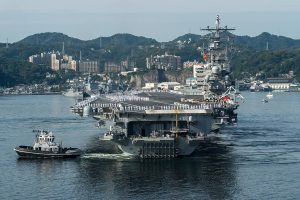The aircraft carrier USS Ronald Reagan has postponed its planned departure from its homeport of Yokosuka seven times over the past 10 days, according to the city authorities. It is very rare for the U.S. nuclear-powered carrier to miss so many scheduled departures in such a short period.
At first, the U.S. Navy notified Japan’s Ministry of Foreign Affairs that the Ronald Reagan would leave the U.S. 7th Fleet’s homeport on September 18 with a crew of 2,953 on board, but that plan was quickly withdrawn, according to the International Relations and Military Base Policy Division of Yokosuka.
Since then, the U.S. Navy has rescheduled and missed at least seven departure dates for the Ronald Reagan, according to the division. Most recently, the carrier, which is the centerpiece of the Ronald Reagan Carrier Strike Group, missed its scheduled departure at 10 a.m. on September 28, a spokesperson at the city’s division said on that day.
The spokesperson said the city has not received any explanation from the U.S. Navy as to why the ship’s departure had been postponed.
“We can’t answer any specific questions about Ronald Reagan’s operations. We can’t answer any questions about the ship’s operations,” a spokesperson at the U.S. Navy’s Yokosuka base told The Diplomat by phone on September 27.
A source familiar with the situation at the Yokosuka base, speaking on the condition of anonymity, said that the reason for the repeated postponement of the ship’s departure may have been a rupture in the pipes connected to the water production system that supplies fresh water to the ship.
“I’ve heard that the problem was caused by flowing high-temperature, high-pressure steam through cold, aging pipes and valves,” the source said, adding that there is no supply of fresh water on board the ship.
“The U.S. military may treat this as a top secret for security reasons,” the source said.
According to measurements taken at the radiation monitoring posts installed at Yokosuka Port, no radiation leakage has been confirmed.
The Ronald Reagan was deployed to Yokosuka Base in October 2015. Since then, the ship has made the base its home port.
According to Yokosuka City, the aircraft carrier last departed from Yokosuka on May 23 and returned on August 25. Stars and Stripes, a U.S. military publication, reported on September 25 that it was part of a customary break at the midway point of a typically six-month-long sea patrol.
The Japanese Ministry of Foreign Affairs on September 28 again notified Yokosuka City that the Ronald Reagan would leave the U.S. 7th Fleet’s homeport on September 29 with a crew of 2,953 on board. However, it is still unclear at this point whether the ship will actually be able to leave the port safely that day.

































